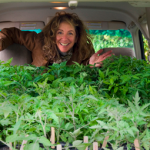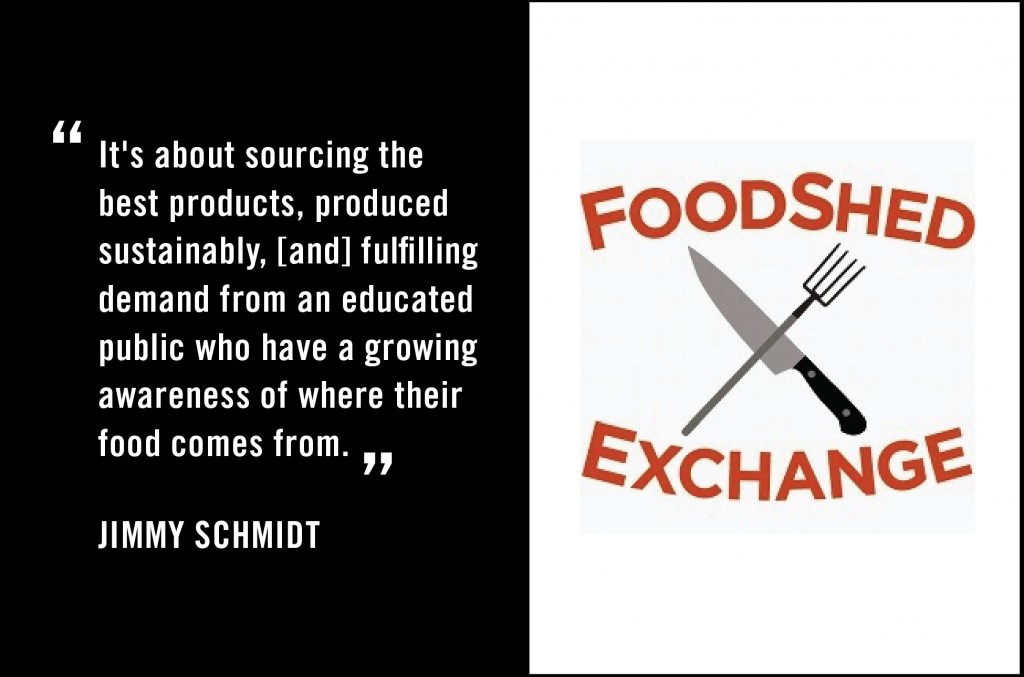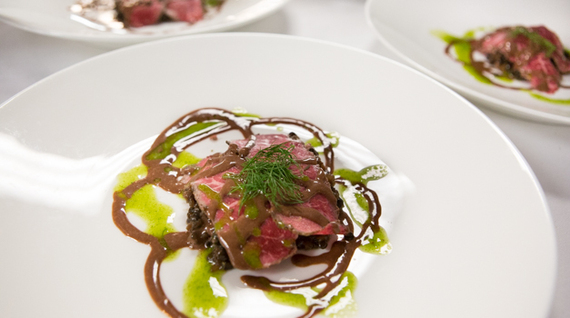Guest post by Julie Ann Fineman and Lee Glenn of Farm Fork Life. The views expressed here are solely those of the authors and do not reflect the views of Food+Tech Connect.
A magic celebration came together recently at Chef Jimmy Schmidt’s Morgan’s in the desert: farmers at the dinner table telling diners about crafting ingredients for a fine meal, 60 guests, inspiring talk, great food from great sources by a great chef.
Knowledge and experience, art and science, beef and wine are what this evening is about. Environmentally sound and economically viable is a world Jimmy visualizes to include conscientious chefs and flourishing farms that enrich healthy communities and serve the health of the planet. The night’s inspiring dinner and discourse is a dynamic step towards this goal.
Celebrating the launch of the FoodShed Exchange, Jimmy brought two distinguished farmers to the table, featuring their work in his engaging, ever-creative menu. Pete Eshelman of the Joseph Decuis Wagyu Farm in Indiana provided Wagyu beef, the Japanese breed known for its nutrient-dense flavor profile and delicate marbling. Bruce and Barbara Neyers of Neyers Vineyards in the Napa Valley provided the wines from their varied cellar that Jimmy paired with a four-course dinner. Though geographically distinct, these progressive producers share the passionate values of providing unique foods, sustainably grown.
Working to build a progressive regional and national food supply system is the core mission of the FoodShed Exchange. This wine pairing dinner represents that vision in microcosm. Pete and Bruce took turns sharing their personal histories and stories on raising superior, fullblood Wagyu and maintaining an organic vineyard to produce exceptional wines. Their experiences compliment each other the way each of Jimmy’s courses complimented the beef and wine.
“I became a farmer at 50 with a history of getting deeply involved,” Pete tells the diners. “I chose Wagyu for its unique flavor and health characteristics and learned the Japanese way of humanely raising the cows. I modeled my farm on those in Hokkaido, we play music to the animals and genetics is the secret.”
“We have brought a variety of wines,” Bruce adds. “There are two Chardonnays from different vineyards, at different altitudes, creating very different profiles. One of our red wines is a Mourvedre which is popular in France and Spain but not in California. It’s a grape used primarily as a blending grape and usually sold as a Zinfandel since very little is planted here. It is very tolerant of warmer weather and with global warming, you may find more of it coming. Try it with that in mind.”
Jimmy explains the core rationale for this dinner and the exposure it provides:
“It’s about sourcing the best products, produced sustainably, fulfilling demand from an educated public who have a growing awareness of where their food comes from. Who is the farmer? How have the animals or crops been grown, raised, fed and treated? Were the animals humanely raised and are they hormone and antibiotic free? These are common questions from my diners.”
The FoodShed Exchange was created to answer these questions while providing an efficient method for progressive chefs to connect to responsible sources. Inspired to provide transparency for his customers and to support eco-friendly suppliers, Jimmy also sought to mitigate the hours spent each week searching for sources that meet his criteria.
To bridge the communication gap between like-minded chefs and sustainable food suppliers, Jimmy is building a platform for chefs to convey their needs to farmers, ranchers and fisherman. Farmers* alert chefs to what is seasonally available. Placing orders, receiving confirmations, invoicing, shipping and payment are all part of the automated program. Completing the circle, respected chef members of the FoodShed Exchange recommend and vet their favorite food suppliers, ensuring economic viability for small to medium sized farmers.* Stories of both chef and farmer* are shared in the Journal section to build awareness, connectivity and transparency for those doing it right.
For this specific menu, Jimmy explains: “Think about two moving parts: a variety of Wagyu cuts and the characteristics of the different wines. Each Wagyu cut has a particular flavor and texture influenced by its fat content. All are known as the most succulent and tender of beef, with the highest content of omega fatty acids. The individual cuts are enhanced by a variety of cooking techniques.”
“Each of the Neyers wines is incredibly balanced, enhanced by the varietal’s flavor profile. Mourvedre, Chardonnay, Cabernet blends are all affected by how they where grown, when they where harvested, the yeast used for fermentation and the type of barrel used for aging. After tasting my way through the Neyers cellar, the challenge was to narrow the field for an incredible menu inspired by the wines themselves.”
Jimmy intuitively defines the flavors and the creative process begins. Tasting the wines, he gets a perspective of what will accentuate each one. After evaluating the flavor profile, he uses ingredients that enhance those flavors while creating balance to ensure they don’t bleed into other components of the finished dish.
Tasting the Mourvedre grown in the Sonoma Valley, but knowing that the Rhone Valley is its origin, Jimmy’s taste buds call for roasted fennel, roasted garlic and black pepper. His creation & recipe: Telecherry Seared Carpaccio of Wagyu Cloaking A Roasted Fennel and Beluga Lentil Risotto, Mourvedre Emulsion and Fennel Fronds.
For Jimmy, this is where science intersects art. A chef with an electrical engineering degree, his knowledge of electrostatic charges allows him to understand emulsions and flavors at a scientific level. Completing the thought process for a specific Wagyu cut, Jimmy concludes: “Mourvedre has lower tannin levels that pair better with leaner cuts of beef, so top sirloin’s my pick for the Carpaccio.”
This dynamic thinking carried through dinner with courses that included Achiote Braised Wagyu Chuck Short Rib Atop Smokey Celery Root Smoothie, Zinfandel Essence and Crispy Shallots paired with 2011 Neyers Zinfandel, followed by Black Spiced Slow Roasted Center of Wagyu Ribeye, Roasted Cauliflower Gratin, Cabernet Tears, Caramelized Royal Trumpets paired with 2009 Neyers Cabernet Sauvignon.
For each course, Pete and Bruce shared the nuances of their foods and their growing practices, while Jimmy provided insight into his creative process. Their personal contribution to the creation of the meal informed the experience and enhanced the sharing with friends, family and new acquaintances. An authentic appreciation was created… between diner and food, between farmer and chef, between diner and farmer… completing the circle.
Hacking Dining is an online conversation exploring how we might use technology and design to hack a better future for dining. Join the conversation between June 2 – July 30, and share your ideas in the comments, on Twitter using #hackdining, Facebook, LinkedIn or Tumblr.
This post originally appeared on Huffington Post on March 11, 2014.
_______________
 Julie Ann Fineman (aka Julie Brothers), journalist, award-winning photographer and founder of the FoodShed Exchange, maintains a personal commitment to supporting sustainable agriculture. Her work includes the Huffington Post series Farm To Fork Across America.
Julie Ann Fineman (aka Julie Brothers), journalist, award-winning photographer and founder of the FoodShed Exchange, maintains a personal commitment to supporting sustainable agriculture. Her work includes the Huffington Post series Farm To Fork Across America.





